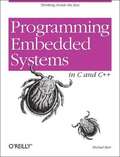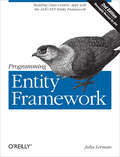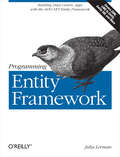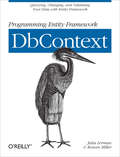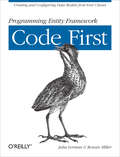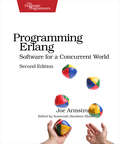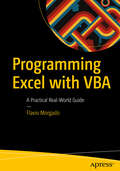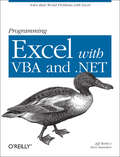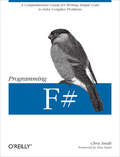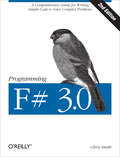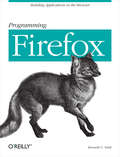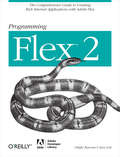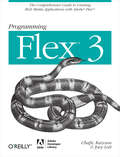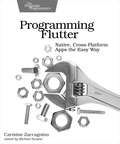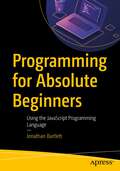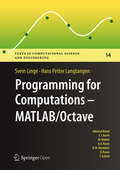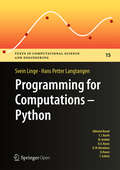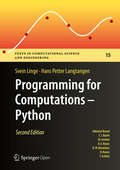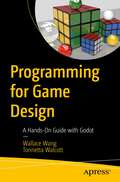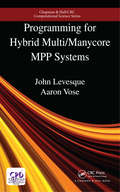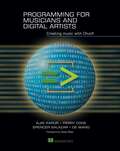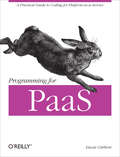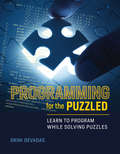- Table View
- List View
Programming Embedded Systems in C and C++
by Michael BarrThis book introduces embedded systems to C and C++ programmers. Topics include testing memory devices, writing and erasing Flash memory, verifying nonvolatile memory contents, controlling on-chip peripherals, device driver design and implementation, optimizing embedded code for size and speed, and making the most of C++ without a performance penalty.
Programming Entity Framework: Building Data Centric Apps with the ADO.NET Entity Framework (Oreilly And Associate Ser.)
by Julia LermanGet a thorough introduction to ADO.NET Entity Framework 4 -- Microsoft's core framework for modeling and interacting with data in .NET applications. The second edition of this acclaimed guide provides a hands-on tour of the framework latest version in Visual Studio 2010 and .NET Framework 4. Not only will you learn how to use EF4 in a variety of applications, you'll also gain a deep understanding of its architecture and APIs.Written by Julia Lerman, the leading independent authority on the framework, Programming Entity Framework covers it all -- from the Entity Data Model and Object Services to WCF Services, MVC Apps, and unit testing. This book highlights important changes for experienced developers familiar with the earlier version.Understand the core concepts you need to make the best use of the EF4 in your applicationsLearn to query your data, using either LINQ to Entities or Entity SQLCreate Windows Forms, WPF, ASP.NET Web Forms, and ASP.NET MVC applicationsBuild and consume WCF Services, WCF Data Services, and WCF RIA ServicesUse Object Services to work directly with your entity objectsCreate persistent ignorant entities, repositories, and write unit testsDelve into model customization, relationship management, change tracking, data concurrency, and moreGet scores of reusable examples -- written in C# (with notes on Visual Basic syntax) -- that you can implement right away
Programming Entity Framework: Code First
by Julia LermanIf you use Entity Framework in Visual Studio 2008 and .NET 3.5, this is the book you want. Programming Entity Framework, 1st Edition offers experienced developers a thorough introduction to Microsoft's core framework for modeling and interacting with data in .NET applications. This hands-on tour provides a deep understanding of Entity Framework's architecture and APIs, and explains how to use the framework in a variety of applications built with Visual Studio 2008 and .NET 3.5.From the Entity Data Model (EDM) and Object Services to EntityClient and the Metadata Workspace, this highly acclaimed first edition covers it all.Understand the core concepts you need to make the best use of the Entity Framework (EF) in your applicationsLearn to query your data, using either LINQ to Entities or Entity SQLCreate Windows Forms, WPF, and ASP.NET applicationsBuild ASMX web services and WCF servicesUse Object Services to work directly with your entity objectsDelve into model customization, relationship management, change tracking, data concurrency, and moreOne important note: while many of the lessons from this book will continue to be valuable as you move to .NET 4, the thoroughly revised second edition of Programming Entity Framework (August 2010) specifically targets Visual Studio 2010 and .NET 4 -- where there have been many advancements and additions to the framework.
Programming Entity Framework: Querying, Changing, and Validating Your Data with Entity Framework (Oreilly And Associate Ser.)
by Julia Lerman Rowan MillerThe DbContext API captures Entity Framework’s (EF) most commonly used features and tasks, simplifying development with EF. This concise book shows you how to use the API to perform set operations with the DbSet class, handle change tracking and resolve concurrency conflicts with the Change Tracker API, and validate changes to your data with the Validation API.With DbContext, you’ll be able to query and update data, whether you’re working with individual objects or graphs of objects and their related data. You’ll find numerous C# code samples to help you get started. All you need is experience with Visual Studio and database management basics.Use EF’s query capabilities to retrieve data, and use LINQ to sort and filter dataLearn how to add new data, and change and delete existing dataUse the Change Tracker API to access information EF keeps about the state of entity instancesControl change tracking information of entities in disconnected scenarios, including NTier applicationsValidate data changes before they’re sent to the database, and set up validation rulesBypass EF’s query pipeline and interact directly with the database
Programming Entity Framework: Creating and Configuring Data Models from Your Classes
by Julia Lerman Rowan MillerTake advantage of the Code First data modeling approach in ADO.NET Entity Framework, and learn how to build and configure a model based on existing classes in your business domain. With this concise book, you’ll work hands-on with examples to learn how Code First can create an in-memory model and database by default, and how you can exert more control over the model through further configuration.Code First provides an alternative to the database first and model first approaches to the Entity Data Model. Learn the benefits of defining your model with code, whether you’re working with an existing database or building one from scratch. If you work with Visual Studio and understand database management basics, this book is for you.Learn exactly what Code First does—and does not—enable you to doUnderstand how property attributes, relationships, and database mappings are inferred from your classes by Code FirstUse Data Annotations and the Fluent API to configure the Code First data modelPerform advanced techniques, such as controlling the database schema and overriding the default model cachingThis book is a continuation of author Julia Lerman’s Programming Entity Framework, widely recognized as the leading book on the topic.
Programming Erlang: Software for a Concurrent World
by Joe ArmstrongA multi-user game, web site, cloud application, or networked database can have thousands of users all interacting at the same time. You need a powerful, industrial-strength tool to handle the really hard problems inherent in parallel, concurrent environments. You need Erlang. In this second edition of the bestselling Programming Erlang, you'll learn how to write parallel programs that scale effortlessly on multicore systems.Using Erlang, you'll be surprised at how easy it becomes to deal with parallel problems, and how much faster and more efficiently your programs run. That's because Erlang uses sets of parallel processes-not a single sequential process, as found in most programming languages. Joe Armstrong, creator of Erlang, introduces this powerful language in small steps, giving you a complete overview of Erlang and how to use it in common scenarios. You'll start with sequential programming, move to parallel programming and handling errors in parallel programs, and learn to work confidently with distributed programming and the standard Erlang/Open Telecom Platform (OTP) frameworks. You need no previous knowledge of functional or parallel programming. The chapters are packed with hands-on, real-world tutorial examples and insider tips and advice, and finish with exercises for both beginning and advanced users.The second edition has been extensively rewritten. New to this edition are seven chapters covering the latest Erlang features: maps, the type system and the Dialyzer, WebSockets, programming idioms, and a new stand-alone execution environment. You'll write programs that dynamically detect and correct errors, and that can be upgraded without stopping the system. There's also coverage of rebar (the de facto Erlang build system), and information on how to share and use Erlang projects on github, illustrated with examples from cowboy and bitcask.Erlang will change your view of the world, and of how you program. What You NeedThe Erlang/OTP system. Download it from erlang.org.
Programming Excel® Services
by Alvin BruneyLearn how to use Excel Services to add spreadsheets and workbooks to your enterprise dashboards and portals. You get real-world examples and code samples to help you enable business intelligence on Microsoft Office SharePoint Server 2007 applications--and simplify information sharing and reuse. Discover how to: Configure Windows SharePoint Products and Technologies, and provision Excel Services Build and debug Web Parts derived from Microsoft .NET Framework or SharePoint base classes Customize and embed objects into Web Parts Extract workbook contents and bind the results to user interface controls with Excel Web Services Load workbooks, perform calculations, and refresh data using Excel Calculation Service Configure Code Access Security for managed user controls Use asynchronous Web Parts to automate Microsoft Office applications PLUS--Get Microsoft Visual C# and Visual Basic code samples on the Web
Programming Excel with VBA: A Practical Real-World Guide
by Flavio MorgadoLearn to harness the power of Visual Basic for Applications (VBA) in Microsoft Excel to develop interesting, useful, and interactive Excel applications. This book will show you how to manipulate Excel with code, allowing you to unlock extra features, accuracy, and efficiency in working with your data. Programming Excel 2016 with VBA is a complete guide to Excel application development, using step-by-step guidance, example applications, and screenshots in Excel 2016.In this book, you will learn:How to interact with key Excel objects, such as the application object, workbook object, and range objectMethods for working with ranges in detail using codeUsage of Excel as a database repositoryHow to exchange data between Excel applicationsHow to use the Windows API to expand the capabilities of ExcelA step-by-step method for producing your own custom Excel ribbonWho This Book Is For:Developers and intermediate-to-advanced Excel users who want to dive deeper into the capabilities of Excel 2016 using code.
Programming Excel with VBA and .NET: Solve Real-World Problems with Excel
by Jeff Webb Steve SaundersWhy program Excel? For solving complex calculations and presenting results, Excel is amazingly complete with every imaginable feature already in place. But programming Excel isn't about adding new features as much as it's about combining existing features to solve particular problems. With a few modifications, you can transform Excel into a task-specific piece of software that will quickly and precisely serve your needs. In other words, Excel is an ideal platform for probably millions of small spreadsheet-based software solutions. The best part is, you can program Excel with no additional tools. A variant of the Visual Basic programming language, VB for Applications (VBA) is built into Excel to facilitate its use as a platform. With VBA, you can create macros and templates, manipulate user interface features such as menus and toolbars, and work with custom user forms or dialog boxes. VBA is relatively easy to use, but if you've never programmed before, Programming Excel with VBA and .NET is a great way to learn a lot very quickly. If you're an experienced Excel user or a Visual Basic programmer, you'll pick up a lot of valuable new tricks. Developers looking forward to .NET development will also find discussion of how the Excel object model works with .NET tools, including Visual Studio Tools for Office (VSTO). This book teaches you how to use Excel VBA by explaining concepts clearly and concisely in plain English, and provides plenty of downloadable samples so you can learn by doing. You'll be exposed to a wide range of tasks most commonly performed with Excel, arranged into chapters according to subject, with those subjects corresponding to one or more Excel objects. With both the samples and important reference information for each object included right in the chapters, instead of tucked away in separate sections, Programming Excel with VBA and .NET covers the entire Excel object library. For those just starting out, it also lays down the basic rules common to all programming languages. With this single-source reference and how-to guide, you'll learn to use the complete range of Excel programming tasks to solve problems, no matter what you're experience level.
Programming F#: A comprehensive guide for writing simple code to solve complex problems (Animal Guide)
by Chris SmithWhy learn F#? This multi-paradigm language not only offers you an enormous productivity boost through functional programming, it also lets you develop applications using your existing object-oriented and imperative programming skills. With Programming F#, you'll quickly discover the many advantages of Microsoft's new language, which includes access to all the great tools and libraries of the .NET platform. Learn how to reap the benefits of functional programming for your next project -- whether it's quantitative computing, large-scale data exploration, or even a pursuit of your own. With this comprehensive guide, F# team member Chris Smith gives you a head start on the fundamentals and advanced concepts of the F# language.Get a clear understanding of functional programming, and how you can use it to simplify code Gain a solid understanding of the language's core syntax, including object-oriented and imperative styles Simplify concurrent and parallel programming with F# Asynchronous Workflows and the Parallel Extensions to .NET Learn advanced F# concepts, such as quotations and computation expressions "This book emphasizes simple, clear explanations of the foundational elements of F#, always with an eye on the enjoyment that comes from programming in general, and programming with F# in particular." Don Syme, Principal Researcher and F# Designer, Microsoft Research
Programming F# 3.0: A Comprehensive Guide for Writing Simple Code to Solve Complex Problems
by Chris SmithWhy learn F#? With this guide, you’ll learn how this multi-paradigm language not only offers you an enormous productivity boost through functional programming, but also lets you develop applications using your existing object-oriented and imperative programming skills. You’ll quickly discover the many advantages of the language, including access to all the great tools and libraries of the .NET platform.Reap the benefits of functional programming for your next project, whether you’re writing concurrent code, or building data- or math-intensive applications. With this comprehensive book, former F# team member Chris Smith gives you a head start on the fundamentals and walks you through advanced concepts of the F# language.Learn F#’s unique characteristics for building applicationsGain a solid understanding of F#’s core syntax, including object-oriented and imperative stylesMake your object-oriented code better by applying functional programming patternsUse advanced functional techniques, such as tail-recursion and computation expressionsTake advantage of multi-core processors with asynchronous workflows and parallel programmingUse new type providers for interacting with web services and information-rich environmentsLearn how well F# works as a scripting language
Programming Firefox
by Kenneth C. FeldtThis is your guide to building Internet applications and user interfaces with the Mozilla component framework, which is best known for the Firefox web browser and Thunderbird email client. Programming Firefox demonstrates how to use the XML User Interface Language (XUL) with open source tools in the framework's Cross-Platform Component (XPCOM) library to develop a variety of projects, such as commercial web applications and Firefox extensions. This book serves as both a programmer's reference and an in-depth tutorial, so not only do you get a comprehensive look at XUL's capabilities--from simple interface design to complex, multitier applications with real-time operations--but you also learn how to build a complete working application with XUL. If you're coming from a Java or .NET environment, you'll be amazed at how quickly large-scale applications can be constructed with XPCOM and XUL. Topics in Programming Firefox include: An overview of Firefox technology An introduction to the graphical elements that compose a XUL application Firefox development tools and the process used to design and build applications Managing an application with multiple content areas Introduction to Resource Description Files, and how the Firefox interface renders RDF Manipulating XHTML with JavaScript Displaying documents using the Scalable Vector Graphics standard and HTML Canvas The XML Binding Language and interface overlays to extend Firefox Implementing the next-generation forms interface through XForms Programming Firefox is ideal for the designer or developer charged with delivering innovative standards-based Internet applications, whether they're web server applications or Internet-enabled desktop applications. It's not just a how-to book, but a what-if exploration that encourages you to push the envelope of the Internet experience.
Programming Flex 2: The Comprehensive Guide to Creating Rich Internet Applications with Adobe Flex
by Chafic Kazoun Joey LottIs there an easier way to build and deliver rich internet applications (RIAs) other than the Flash IDE or Ajax? Absolutely. With Adobe Flex 2, the Flex 2 SDK, and this book, you have all you need to build RIAs. Programming Flex 2 offers you plenty of practical and useful examples that reveal how and why to use a particular feature of Flex 2, and when and when not to. As part of the Adobe Developer Library, Programming Flex 2 is the authoritative guide to this new Adobe framework. You learn to use a markup language called MXML and a vast library of off-the-shelf and highly-configurable components to build Flash-based applications that combine the immediacy of the Web with the functionality and responsiveness of desktop applications. You also discover why -- with the Flash Player runtime environment and the powerful ActionScript 3.0 programming language -- the possibilities with Flex 2 are nearly limitless. Topics include: Managing LayoutWorking with ComponentsWorking with MediaManaging StateUsing Transitions and EffectsWorking with DataCustomizing Application AppearanceClient Data Communication and Remote Data CommunicationDebugging Flex Framework ApplicationsCreating Custom Components Flex may be easier to learn than the Flash IDE, but you still need a reliable guide to the framework. Programming Flex 2 not only serves as a reference, but provides valuable and practical insight into this new technology. As you learn how to build Flex applications, you'll also discover how Flex works. This book supplies all the information you need in one convenient place. Adobe Developer Library is a co-publishing partnership between O'Reilly Media and Adobe Systems, Inc. and is designed to produce the number one information resources for developers who use Adobe technologies. Created in 2006, the Adobe Developer Library is the official source for comprehensive learning solutions to help developers create expressive and interactive web applications that can reach virtually anyone on any platform. With top-notch books and innovative online resources covering the latest in rich Internet application development, the Adobe Developer Library offers expert training and in-depth resources, straight from the source.
Programming Flex 3: The Comprehensive Guide to Creating Rich Internet Applications with Adobe Flex
by Chafic Kazoun Joey LottIf you want to try your hand at developing rich Internet applications with Adobe's Flex 3, and already have experience with frameworks such as .NET or Java, this is the ideal book to get you started. Programming Flex 3 gives you a solid understanding of Flex 3's core concepts, and valuable insight into how, why, and when to use specific Flex features. Numerous examples and sample code demonstrate ways to build complete, functional applications for the Web, using the free Flex SDK, and RIAs for the desktop, using Adobe AIR. This book is an excellent companion to Adobe's Flex 3 reference documentation. With this book, you will:Learn the underlying details of the Flex frameworkProgram with MXML and ActionScriptArrange the layout and deal with UI componentsWork with mediaManage state for applications and componentsUse transitions and effectsDebug your Flex applicationsCreate custom componentsEmbed Flex applications in web browsersBuild AIR applications for the desktopFlex 3 will put you at the forefront of the RIA revolution on both the Web and the desktop. Programming Flex 3 will help you get the most from this amazing and sophisticated technology.
Programming Flutter: Native, Cross-Platform Apps the Easy Way
by Carmine ZaccagninoWork in Flutter, a framework designed from the ground up for dual platform development, with support for native Java/Kotlin or Objective-C/Swift methods from Flutter apps. Write your next app in one language and build it for both Android and iOS. Deliver the native look, feel, and performance you and your users expect from an app written with each platform's own tools and languages. Deliver apps fast, doing half the work you were doing before and exploiting powerful new features to speed up development. Write once, run anywhere. Learn Flutter, Google's multi-platform mobile development framework. Instantly view the changes you make to an app with stateful hot reload and define a declarative UI in the same language as the app logic, without having to use separate XML UI files. You can also reuse existing platform-specific Android and iOS code and interact with it in an efficient and simple way. Use built-in UI elements - or build your own - to create a simple calculator app. Run native Java/Kotlin or Objective-C/Swift methods from your Flutter apps, and use a Flutter package to make HTTP requests to a Web API or to perform read and write operations on local storage. Apply visual effects to widgets, create transitions and animations, create a chat app using Firebase, and deploy everything on both platforms. Get native look and feel and performance in your Android and iOS apps, and the ability to build for both platforms from a single code base. What You Need: Flutter can be used for Android development on any Linux, Windows or macOS computer, but macOS is needed for iOS development.
Programming for Absolute Beginners: Using the JavaScript Programming Language
by Jonathan BartlettNew programmers start here...this book introduces students or aspiring professionals to the world of computer programming using JavaScript and related technologies. This book doesn't just teach the basics of programming, but also all of the tools that new programmers need to get started, including the basics of making web pages and how the Internet works. Programming for Absolute Beginners offers practice problems, activities, and a host of resources to get new programmers started, plus a large glossary of terms introduced in the book and that a new programmer might encounter when learning on their own. No special software is required; this book will help you regardless of what your computer setup is, and source code will be freely available via GitHub.What You Will LearnHow computers workHow computers communicate over networksHow web pages are built with HTML and CSSHow JavaScript worksHow JavaScript interacts with web pagesIntermediate JavaScript topics such as recursion and scopingUsing JavaScript for network communication Who This Book Is ForAnyone wanting to begin computer programming, including students who need to learn the fundamentals and early professionals who want to go back and revisit the basics.
Programming for Computations - MATLAB/Octave
by Svein Linge Hans Petter LangtangenThis book presentscomputer programming as a keymethod for solving mathematical problems. There are two versions of the book,one for MATLAB and onefor Python. The book wasinspired by the Springer bookTCSE 6: A Primer on Scientific Programming with Python (by Langtangen), but the style is more accessible andconcise, in keeping with the needs of engineering students. The book outlines the shortest possible path from no previous experience with programming to a set ofskills that allows the students to write simple programs for solving commonmathematical problems withnumerical methods in engineering and science courses. The emphasis is on generic algorithms, cleandesign of programs, use of functions, and automatic tests for verification.
Programming for Computations - Python
by Svein Linge Hans Petter LangtangenThis book presentscomputer programming as a keymethod for solving mathematical problems. There are two versions of the book,one for MATLAB and onefor Python. The book wasinspired by the Springer bookTCSE 6: A Primer on Scientific Programming with Python (by Langtangen), but the style is more accessible andconcise, in keeping with the needs of engineering students. The book outlines the shortest possible path from no previous experience with programming to a set ofskills that allows the students to write simple programs for solving commonmathematical problems withnumerical methods in engineering and science courses. The emphasis is on generic algorithms, cleandesign of programs, use of functions, and automatic tests for verification.
Programming for Computations - Python: A Gentle Introduction to Numerical Simulations with Python 3.6 (Texts in Computational Science and Engineering #15)
by Svein Linge Hans Petter LangtangenThis book is published open access under a CC BY 4.0 license. This book presents computer programming as a key method for solving mathematical problems. This second edition of the well-received book has been extensively revised: All code is now written in Python version 3.6 (no longer version 2.7). In addition, the two first chapters of the previous edition have been extended and split up into five new chapters, thus expanding the introduction to programming from 50 to 150 pages. Throughout the book, the explanations provided are now more detailed, previous examples have been modified, and new sections, examples and exercises have been added. Also, a number of small errors have been corrected. The book was inspired by the Springer book TCSE 6: A Primer on Scientific Programming with Python (by Langtangen), but the style employed is more accessible and concise, in keeping with the needs of engineering students. The book outlines the shortest possible path from no previous experience with programming to a set of skills that allows students to write simple programs for solving common mathematical problems with numerical methods in the context of engineering and science courses. The emphasis is on generic algorithms, clean program design, the use of functions, and automatic tests for verification.
Programming for Game Design: A Hands-On Guide with Godot
by Wallace Wang Tonnetta WalcottCreate video game elements using the Godot game engine, gaining practical experience in programming and video game development. The Godot game engine uses a simplified programming language called GDScript, which closely resembles Python. By learning GDScript, you can focus more on learning the basics of programming. You’ll explore concepts such as variables and data structures variables used to store information about video game objects that can be manipulated using a keyboard or a mouse. You’ll also learn about user interface design, branching statements, and looping statements, enabling you to actively engage in programming and create your own interactive games. By the end of the book, you’ll have a solid understanding of how video game elements work and how the basic principles of programming work as well. By programming simple video game elements in the Godot game engine, you’ll learn both programming and the principles of 2D video game design.What You Will LearnUnderstand the basics of programming by creating simple video game elements in the Godot game engine.Explore variables and data structures to actively store and modify information about video game objects.Gain a deeper understanding of user interface design.Master simplified programming languages like GDScript.Who This Book Is For Aspiring programmers and game enthusiasts seeking an engaging introduction to programming through video game creation.
Programming for Hybrid Multi/Manycore MPP Systems (Chapman & Hall/CRC Computational Science)
by John Levesque Aaron Vose"Ask not what your compiler can do for you, ask what you can do for your compiler."--John Levesque, Director of Cray’s Supercomputing Centers of Excellence <P><P>The next decade of computationally intense computing lies with more powerful multi/manycore nodes where processors share a large memory space. These nodes will be the building block for systems that range from a single node workstation up to systems approaching the exaflop regime. The node itself will consist of 10’s to 100’s of MIMD (multiple instruction, multiple data) processing units with SIMD (single instruction, multiple data) parallel instructions. Since a standard, affordable memory architecture will not be able to supply the bandwidth required by these cores, new memory organizations will be introduced. These new node architectures will represent a significant challenge to application developers. <P><P>Programming for Hybrid Multi/Manycore MPP Systems attempts to briefly describe the current state-of-the-art in programming these systems, and proposes an approach for developing a performance-portable application that can effectively utilize all of these systems from a single application. The book starts with a strategy for optimizing an application for multi/manycore architectures. It then looks at the three typical architectures, covering their advantages and disadvantages. <P><P>The next section of the book explores the other important component of the target—the compiler. The compiler will ultimately convert the input language to executable code on the target, and the book explores how to make the compiler do what we want. The book then talks about gathering runtime statistics from running the application on the important problem sets previously discussed. <P><P>How best to utilize available memory bandwidth and virtualization is covered next, along with hybridization of a program. The last part of the book includes several major applications, and examines future hardware advancements and how the application developer may prepare for those advancements.
Programming for Musicians and Digital Artists: Creating music with ChucK
by Ge Wang Spencer Salazar Ajay Kapur Perry CookSummaryProgramming for Musicians and Digital Artists: Creating Music with ChucK offers a complete introduction to programming in the open source music language ChucK. In it, you'll learn the basics of digital sound creation and manipulation while you discover the ChucK language. As you move example-by-example through this easy-to-follow book, you'll create meaningful and rewarding digital compositions and "instruments" that make sound and music in direct response to program logic, scores, gestures, and other systems connected via MIDI or the network.Purchase of the print book includes a free eBook in PDF, Kindle, and ePub formats from Manning Publications.About this BookA digital musician must manipulate sound precisely. ChucK is an audio-centric programming language that provides precise control over time, audio computation, and user interface elements like track pads and joysticks. Because it uses the vocabulary of sound, ChucK is easy to learn even for artists with little or no exposure to computer programming.Programming for Musicians and Digital Artists offers a complete introduction to music programming. In it, you'll learn the basics of digital sound manipulation while you learn to program using ChucK. Example-by-example, you'll create meaningful digital compositions and "instruments" that respond to program logic, scores, gestures, and other systems connected via MIDI or the network. You'll also experience how ChucK enables the on-the-fly musical improvisation practiced by communities of "live music coders" around the world.Written for readers familiar with the vocabulary of sound and music. No experience with computer programming is required.What's InsideLearn ChucK and digital music creation side-by-sideInvent new sounds, instruments, and modes of performanceWritten by the creators of the ChucK languageAbout the AuthorsPerry Cook, Ajay Kapur, Spencer Salazar, and Ge Wang are pioneers in the area of teaching and programming digital music. Ge is the creator and chief architect of the ChucK language.Table of ContentsIntroduction: ChucK programming for artistsPART 1 INTRODUCTION TO PROGRAMMING IN CHUCKBasics: sound, waves, and ChucK programmingLibraries: ChucK's built-in toolsArrays: arranging and accessing your compositional dataSound files and sound manipulationFunctions: making your own toolsPART 2 NOW IT GETS REALLY INTERESTING!Unit generators: ChucK objects for sound synthesis and processingSynthesis ToolKit instrumentsMultithreading and concurrency: running many programs at onceObjects and classes: making your own ChucK power toolsEvents: signaling between shreds and syncing to the outside worldIntegrating with other systems via MIDI, OSC, serial, and more
Programming for PaaS: A Practical Guide to Coding for Platform-as-a-Service
by Lucas CarlsonPlatform-as-a-Service (PaaS) is gaining serious traction among web and mobile developers, but as new PaaS providers emerge and existing vendors upgrade their features, it’s hard to keep track of what PaaS has to offer. This thorough introduction takes you through the PaaS model from a developer’s point of view, and breaks down the types of services that Google App Engine, Windows Azure, Heroku, Cloud Foundry, and others deliver.Whether you’re an entrepreneur or part of a large enterprise development team, this book shows you how PaaS can help you focus on innovative applications, rather than spend your time worrying about technical operations.Track the cloud’s evolution from IaaS and DevOps to PaaSLearn how PaaS combines the simplicity of shared web hosting with the control of dedicated hostingExplore the benefits of both portable and non-portable PaaS optionsApply best practices for moving legacy apps to PaaS—and understand the challenges involvedWrite new applications for PaaS from scratch with RESTful meta-servicesUse PaaS to build mobile apps with backend services that scaleExamine the core services that each major provider currently offersLearn the situations in which PaaS might not be advantageous
Programming for the Puzzled: Learn to Program While Solving Puzzles (The\mit Press Ser.)
by Srini DevadasLearning programming with one of “the coolest applications around”: algorithmic puzzles ranging from scheduling selfie time to verifying the six degrees of separation hypothesis.This book builds a bridge between the recreational world of algorithmic puzzles (puzzles that can be solved by algorithms) and the pragmatic world of computer programming, teaching readers to program while solving puzzles. Few introductory students want to program for programming's sake. Puzzles are real-world applications that are attention grabbing, intriguing, and easy to describe. Each lesson starts with the description of a puzzle. After a failed attempt or two at solving the puzzle, the reader arrives at an Aha! moment—a search strategy, data structure, or mathematical fact—and the solution presents itself. The solution to the puzzle becomes the specification of the code to be written. Readers will thus know what the code is supposed to do before seeing the code itself. This represents a pedagogical philosophy that decouples understanding the functionality of the code from understanding programming language syntax and semantics. Python syntax and semantics required to understand the code are explained as needed for each puzzle.Readers need only the rudimentary grasp of programming concepts that can be obtained from introductory or AP computer science classes in high school. The book includes more than twenty puzzles and more than seventy programming exercises that vary in difficulty. Many of the puzzles are well known and have appeared in publications and on websites in many variations. They range from scheduling selfie time with celebrities to solving Sudoku problems in seconds to verifying the six degrees of separation hypothesis. The code for selected puzzle solutions is downloadable from the book's website; the code for all puzzle solutions is available to instructors.
Programming for Unified Communications with Microsoft® Office Communications Server 2007 R2
by Chris Mayo Kurt De Ding Oscar Newkerk Rui Maximo Vishwa RanjanDirect from the Microsoft Office Communications Server product team, get the hands-on guidance you need to streamline your organization's real-time, remote communication and collaboration solutions across the enterprise and across time zones.
